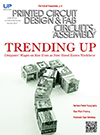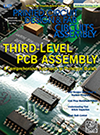2014 Issues

FEATURES
REWORK
Shielding Effectiveness of Polyimide Tape During Rework
A study during which repeated measurements were taken of maximum outlying component temperatures during reflow proved Kapton tape is an inferior shielding material. But what beat it was a surprise.
by Adam Gaynor and Bob Wettermann
SCREEN PRINTING
Advances in Fine-Pitch Printing Process Technology
Thinner stencils, smaller particle size solder paste and smaller apertures, whereby even aperture shape becomes a factor in volume fill, test the limits of the successful printing process. Achieving sufficient or acceptable paste volume fill of fine-feature apertures has become an issue. Comparative test results show how greater precision and motion control, closed-loop feedback systems, enclosed media printing, and machine vision are contributing to process improvemen.
by Isaiah Smith
ASM-DEK
ASM Takes Root in SMT
With two major acquisitions in a three-year span, including its just concluded takeover of DEK, ASM Pacific Technology is fashioning itself into a major player in electronics process equipment. Just don’t expect many changes, from the name on the door to even where the door is situated.
by Chelsey Drysdale
TESTING
Solder Joint Integrity Test for Finding Latent Defects in PCBs
A new method to find latent defects uses a 4-wire small resistance measurement technique built into a flying-probe ICT to measure resistance between component leads and pads and check solder volume. Because solder volume is inversely proportional to the resistance in-between, the resistance measurement is a way to test solderability.
by Hiroshi Yamazaki
FIRST PERSON
-
CAVEAT LECTOR
There may never be another like Viasystems.
Mike Buetow
MONEY MATTERS
-
ROI
Out of fashion but not out of factory.
Peter Bigelow -
FOCUS ON BUSINESS
Maximizing the program manager.
Susan Mucha
TECH TALK
-
FINAL FINISHES
The upside of rough topography.
Lenora Toscano
-
SCREEN PRINTING
Small parts, small powders?
Clive Ashmore - TEST AND INSPECTION
Expanding test coverage.
Jun Balangue - DEFECTS DATABASE
Why you should check the plating adhesion.
Dr. Chris Hunt

FEATURES
COVER STORY
A Two-Team Race?
Apple and Samsung are the top customers of nine of the 20 largest PCB fabricators, and as the annual NTI-100 list demonstrates, those makers did well in 2013. Is their success sustainable?
by Dr. Hayao Nakahara
CLEANING
Cleanliness Assessment for Class III Lead-Free No-Clean Assemblies
Using IPC test coupons and standards, a study identifies and qualifies an aqueous cleaning process capable of removing combinations of no-clean flux residues for high-rel boards.
by Ravi Parthasarathy, Umut Tosun and Michael McCutchen
WASH BATH CONTROL
Concentration Monitoring Closed Loop Control – Phase 2
An evaluation of extensive flowsensor field data generated from two locations finds that, although contamination in the form of flux residues accumulates in the cleaning system over time, acoustic measurement technology can accurately indicate and control wash bath concentration.
by Umut Tosun, Axel Vargas and Bryan Kim, Ph.D.
SIR TESTING
New Requirements for SIR Measurement
Requirements for no-clean solder paste to increase device chemical, thermal and electrical reliability.
by Jörg Trodler and Prof. Mathias Nowottnick
FIRST PERSON
-
CAVEAT LECTOR
From the minds of babes.
Mike Buetow
MONEY MATTERS
-
ROI
On pride and perceptions.
Peter Bigelow -
FOCUS ON BUSINESS
Staying on message in the EMS arena.
Susan Mucha
TECH TALK
-
SCREEN PRINTING
Understencil cleaning.
Clive Ashmore
-
TEST AND INSPECTION
Evaluating digital-analog converters.
Cynthia Chuah

FEATURES
INSPECTION
What is FAI, and What is the Purpose?
While SAE AS9102 defines first article inspection and its purpose, there is often confusion regarding that definition and its importance to an OEM. These concerns cause havoc in both the design and production worlds. Here, a leading defense contractor clears up FAI.
by Karen Ebner, Charles A. Hill and G. Wilkish
PACKAGING
Characteristics of a Third-Level PCB Assembly
Under typical circumstances, engineers won’t know whether a design will work until the prototype is built. A package “implementation” approach, rather than package “installation” approach, can help EMS firms comply with OEM requirements.
by Mueed Khan
WASH BATH CONTROL
Concentration Monitoring Closed Loop Control – Phase 2
An evaluation of extensive flowsensor field data generated from two locations finds that, although contamination in the form of flux residues accumulates in the cleaning system over time, acoustic measurement technology can accurately indicate and control wash bath concentration.
by Umut Tosun, Axel Vargas and Bryan Kim, Ph.D.
DISPENSING
Automated Dispensing of Two-Component Materials in Electronics Assembly
Fluid dispensing is often a neglected topic in electronics production and technical discussions. However, fluids can literally be the “glue” that completes the component, device or assembly for its structural design. Fluids can also be used for thermal management, optical filtering, sealing, or protection against environmental factors, which enhance the reliability of the (final) assembly. Advantages, disadvantages, and challenges of using two component formulations in automated dispensing and conformal coating.
by Per Orla-Jensen
FIRST PERSON
-
CAVEAT LECTOR
Material loss.
Mike Buetow
MONEY MATTERS
-
ROI
Service with a smile.
Peter Bigelow -
FOCUS ON BUSINESS
Priced to win.
Joseph Fama
TECH TALK
-
ON THE FOREFRONT
ECTC: a packaging heaven.
E. Jan Vardaman -
GETTING LEAN
Counting the data.
Ron Feyereisen
-
TECH TIPS
More whiskers.
Karl Seelig and Tim O’Neill -
DEFECTS DATABASE
Open circuits on PoP.
Dr. Chris Hunt
-
TEST AND INSPECTION
I’m your answer.
Robert Boguski


